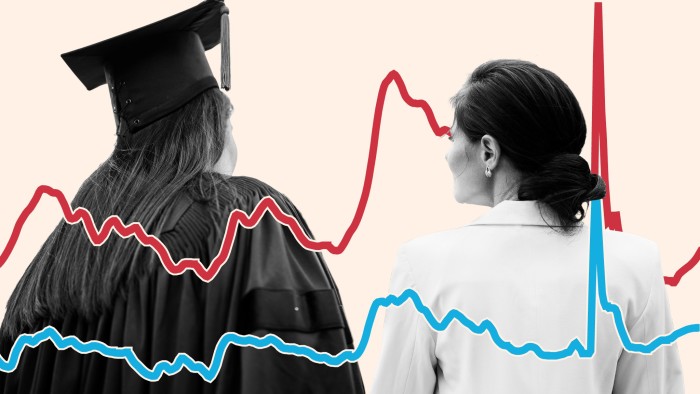Unlock the Editor’s Digest for free
Roula Khalaf, Editor of the FT, selects her favourite stories in this weekly newsletter.
You would have to be living under a rock to have escaped the labour market story of the past year: the great graduate unemployment crunch. Long used to weathering economic storms better than their uncredentialled contemporaries, recent recipients of a degree have found joblessness climbing more steeply lately than those without one, from the US to Europe.
But what if this tale of graduate-specific woe is off-beam, based on a misguided analysis of the data? What if the accompanying narratives that seek to explain why the most educated are faring especially badly are focused on a mirage?
To set the scene: we know that rising unemployment is mainly down to weak hiring, not job losses. This dynamic is particularly important for new entrants to the labour market. Analysis of joblessness among recent US graduates confirms this: the rise is almost exclusively accounted for by the struggles of those freshly out of the education system.
But the studies that have found a less favourable picture for recent college graduates compared with their non-college contemporaries make a crucial mis-step in restricting their analysis to people in their mid-twenties.
A 23-year-old college graduate newly looking for a job is highly exposed to the current hiring slowdown. A 23-year-old who exited the education system several years ago aged 18 entered a different, more buoyant labour market, making them far less exposed to the sudden freeze in hiring today. This is not a like-for-like comparison.
To determine whether recent graduates are having an especially tough time in 2025’s low-hiring environment, the comparison we should make instead is with others who recently entered the labour market for the first time, regardless of age. A newly job-seeking graduate might be in their mid-twenties, but someone entering the world of work straight from high school will be several years younger.
Once we do this, it turns out that those without a degree are actually having a much harder time of it. In the US, unemployment among recent college graduates is up 1.3 percentage points from its mid-2022 low, but by almost double that among recent labour market entrants without a degree, who have seen a 2.4 point rise. This is very different to the much more modest 0.7 point rise among the frequently — but inappropriately — cited group of non-grads in their mid-twenties who are sheltered from today’s harsh hiring conditions.
Applying the same adjustment on the other side of the Atlantic reveals a similar pattern in western Europe: young workers without a degree have seen an uptick in joblessness rates of 2.4 percentage points on average compared with 1.4 for recent graduates.
None of this is to make light of the headwinds facing the newest cohorts emerging with a degree. But those winds are battering all young labour market entrants regardless of education level, and if anything employment outcomes are worsening more rapidly for those with fewer skills looking for blue-collar jobs than the highly skilled seeking knowledge work.
Getting this story right matters for two reasons. First, because those with the fewest qualifications are at much higher risk of being tipped into long-term worklessness.
And second, because of what this means for the secondary narratives shaped by this primary one. When we think about a force that is hitting graduates especially hard, we look for explanations that apply especially to early-career white-collar work. Generative AI, for example. But evidence for the kind of large-scale AI-driven displacement of early-career knowledge-sector jobs that would explain broad-based graduate malaise remains conspicuous by its absence.
When viewed instead as a broader cooling of the labour market, in which inexperienced workers of all stripes bear the brunt (and especially those with the least skills) we don’t need to reach for such exotic explanations. The unwinding of extremely tight post-pandemic labour markets, rising input costs from inflation, tax changes and tariffs, plus the broader economic uncertainty during Donald Trump’s second term, are sufficient to explain what we’re seeing.
Young adults today undoubtedly face a tough job market, but framing this as uniquely or especially affecting graduates has muddied rather than clarified the picture.
john.burn-murdoch@ft.com, @jburnmurdoch
Data sources and methodology
US unemployment rates were calculated using the Current Population Survey. Absent timely data on precisely when an individual entered the labour market, recent entrants are defined as those aged 22-27 for graduates (in line with the approach taken by the New York Fed), and 19-24 for non-graduates, such that in both cases the group in question transitioned from education to the labour market in the previous 1-5 years.
Western European countries are Belgium, Denmark, Germany, Finland, France, Ireland, the Netherlands, Norway, Sweden and Switzerland. Due to the limited number of pre-specified age groups available in the Eurostat data used for this analysis, recent entrants are defined as those aged 20-29 for graduates and 15-24 for non-graduates.

